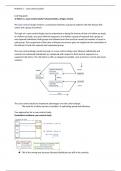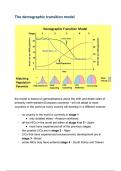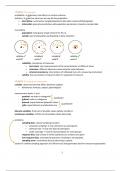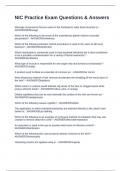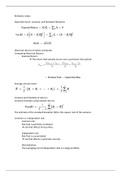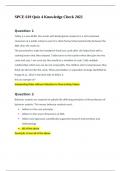Problem 2 – case control studies
Learning goals:
1) What is a case-control study? (characteristics, design, choice)
The case-control design involves a comparison between a group of patients with the disease (the
cases) and a group of controls.
The logic of a case-control design can be understood as being the inverse of that of a follow-up study.
In a follow-up study, one starts with the exposure; one defines a group of exposed and a group of
non-exposed individuals. Both groups are followed over time and one counts the number of cases in
each group. The comparison of the rates of disease occurrence gives an insight into the association of
the disease in both the exposed and unexposed group.
The case-control design works inversely. In a case-control study cases (disease individuals) and
controls (non-diseased individuals) are compared with respect to their level of exposure to a
suspected risk factor. The risk factor is often a categorical variable, such as former, current and never
smokers.
The case-control study has important advantages over the cohort design:
- The need for a follow-up time is avoided optimizing speed and efficiency
Two approaches for a case-control study:
Cumulative incidence case-control study
This is the wrong way because diseased individuals are still in the controls.
,Problem 2 – case control studies
In this way you exclude the diseased cases when calculating the controls.
o Total controls exposed = 1000 – 100: 900
o Total controls unexposed = 4000 – 200: 3800
o Total controls = 900 + 3800: 4700
If you want in total 600 controls and have to calculate the fractions of exposed and unexposed:
o Exposed = (900/4700) x 600 : 115
o Unexposed = (3800/4700) x 600 : 485
The cases and controls are selected at the same time in one time point
Assumptions:
- OR ≈ CIR only if the disease is rare (10%)
- Exposure status may change over time
- Controls may not be representative of the time at risk
o Control selection at one point in time may introduce bias
Incidence density case-control study
Controls are selected at the same time when a diseased case is identified.
, Problem 2 – case control studies
Assumptions:
- OR ≈ IDR even if disease is not rare; because you sample them both at the same time.
- Concurrent sampling of controls
- Exposure status at time of case or controls selection
Advantages:
- Rare disease
- Efficient (time and costs)
Disadvantage:
- Selection bias
- Rare exposures
2) Why do you need controls in a case-control study?
The aim of a case-control study is to examine if there is a difference in effect in exposure status
between cases who have the disease and control who are at risk for the disease. Hereby one could
conclude of a certain exposure contribute to the development of the disease. If you only include
cases you can not make a proper conclusion about the exposure.
Eliminate the effect of other factors if you choice the controls
You could match cases and controls based on confounding factors; but you need still correct
for them in your analysis.
3) How do you selects controls and cases?
Assumptions:
- Sampling rates of controls are independent of exposure.
- The chance of being selected as a control among exposed is the same as the change of being
selected as a control among non-exposed.
- The ratio of control to time at risk is the same for exposed and non-exposed.
Principles of selecting of controls
Literature: Selection of controls in case-control studies Wacholder et. al.
Comparability principle
The basic tenets of comparability underlie attempts to minimize bias in control selection. These are
the principles:
- Study base principle
Cases and controls should be representative of the same base experience. The base is the set of
persons in which diseased subjects become cases. The base can also be thought of as the members
of the underlying cohort or source population for the cases during the time periods when they are
eligible to become cases.
The simplest way to satisfy this principle is to choose a random sample of individuals form the same
source as the cases. The sampling should be from the members of the base at risk at the same as the
Learning goals:
1) What is a case-control study? (characteristics, design, choice)
The case-control design involves a comparison between a group of patients with the disease (the
cases) and a group of controls.
The logic of a case-control design can be understood as being the inverse of that of a follow-up study.
In a follow-up study, one starts with the exposure; one defines a group of exposed and a group of
non-exposed individuals. Both groups are followed over time and one counts the number of cases in
each group. The comparison of the rates of disease occurrence gives an insight into the association of
the disease in both the exposed and unexposed group.
The case-control design works inversely. In a case-control study cases (disease individuals) and
controls (non-diseased individuals) are compared with respect to their level of exposure to a
suspected risk factor. The risk factor is often a categorical variable, such as former, current and never
smokers.
The case-control study has important advantages over the cohort design:
- The need for a follow-up time is avoided optimizing speed and efficiency
Two approaches for a case-control study:
Cumulative incidence case-control study
This is the wrong way because diseased individuals are still in the controls.
,Problem 2 – case control studies
In this way you exclude the diseased cases when calculating the controls.
o Total controls exposed = 1000 – 100: 900
o Total controls unexposed = 4000 – 200: 3800
o Total controls = 900 + 3800: 4700
If you want in total 600 controls and have to calculate the fractions of exposed and unexposed:
o Exposed = (900/4700) x 600 : 115
o Unexposed = (3800/4700) x 600 : 485
The cases and controls are selected at the same time in one time point
Assumptions:
- OR ≈ CIR only if the disease is rare (10%)
- Exposure status may change over time
- Controls may not be representative of the time at risk
o Control selection at one point in time may introduce bias
Incidence density case-control study
Controls are selected at the same time when a diseased case is identified.
, Problem 2 – case control studies
Assumptions:
- OR ≈ IDR even if disease is not rare; because you sample them both at the same time.
- Concurrent sampling of controls
- Exposure status at time of case or controls selection
Advantages:
- Rare disease
- Efficient (time and costs)
Disadvantage:
- Selection bias
- Rare exposures
2) Why do you need controls in a case-control study?
The aim of a case-control study is to examine if there is a difference in effect in exposure status
between cases who have the disease and control who are at risk for the disease. Hereby one could
conclude of a certain exposure contribute to the development of the disease. If you only include
cases you can not make a proper conclusion about the exposure.
Eliminate the effect of other factors if you choice the controls
You could match cases and controls based on confounding factors; but you need still correct
for them in your analysis.
3) How do you selects controls and cases?
Assumptions:
- Sampling rates of controls are independent of exposure.
- The chance of being selected as a control among exposed is the same as the change of being
selected as a control among non-exposed.
- The ratio of control to time at risk is the same for exposed and non-exposed.
Principles of selecting of controls
Literature: Selection of controls in case-control studies Wacholder et. al.
Comparability principle
The basic tenets of comparability underlie attempts to minimize bias in control selection. These are
the principles:
- Study base principle
Cases and controls should be representative of the same base experience. The base is the set of
persons in which diseased subjects become cases. The base can also be thought of as the members
of the underlying cohort or source population for the cases during the time periods when they are
eligible to become cases.
The simplest way to satisfy this principle is to choose a random sample of individuals form the same
source as the cases. The sampling should be from the members of the base at risk at the same as the

